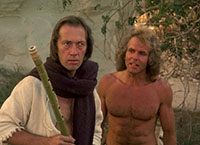
Bruce Lee and “The Way of the Intercepting Fist”
June 21, 2016
Bruce taught me to dissect time into infinite degrees. It’s what he called ‘playing between the keys of the piano.’ It’s the understanding that you actually have worlds of time within seconds to do something unanticipated when your opponent is already committed to his announced [telegraphed] action.”
Sterling Silliphant, Bruce Lee: FIghting Words
In 1971, a quirky TV movie aired on the ABC Movie of the Week called Longstreet .
The movie was written by Sterling Silliphant , an Oscar winning writer ( In the Heat of the Night ) and a student of Bruce Lee. The show was picked up as a series whose debut episode was called “The Way of the Intercepting Fist.”
Silliphant was Bruce’s student in that 3 year “in-between” period (after The Green Hornet and before his first feature film, The Big Boss ).
He also got Bruce some Hollywood work, writing him a memorable cameo in the James Garner movie Marlowe , where Bruce is a Mob enforcer who destroys Marlowe’s office . He also wrote Bruce a pivotal role for Longstreet .
Longstreet was a detective show about an insurance investigator who, while investigating some jewel thefts, is blinded and widowed by an explosion meant to silence him. A key character in the early shows was Li Tsung, who helps Longstreet regain his independence, basically by teaching him Wing Chun / Jeet Kune Do.
Duke Paige
:
What is this thing you do?
Li Tsing
:
In Catonese, Jeet Kune Do – the way of the intercepting fist.
Duke Paige
:
Intercepting fist, huh?
One of the things I find most interesting about this show is how much of Bruce’s subsequent media image seems to have been formed by this series. Whole swaths of the dialog show up in other media, such as Enter the Dragon (“boards don’t hit back”) and in Bruce’s famous interview with Pierre Berton (Be like water, my friend”).
I suspect this is because Silliphant was able to artfully take Bruce’s teachings and style of speaking and turn it into great dialog. Then Bruce naturally was able to use these well-written versions of his teachings which he had memorized for the show. Or, Silliphant just put Bruce’s words and metaphors in the screenplay (giving Bruce more credit!).
I saw this show when it aired (I was 9). I was of course interested in the discussions of how to fight (being a small kid and a wise ass, a bad combination resulting in the occasional beat down). I was intrigued by the combination of philosophy and violence explored on the show. Bruce often said very ambiguous things, which drew me in with more force, the mystery something to chew on, like the Japanese kōan . What does that mean? Fighting without fighting? No style? Even at 9, these words were intriguing and mysterious.
If Bruce had lived, his plan was to make a martial arts movie which would explore this line between Eastern philosophy and fighting, a film he had written with the help of friends and students James Coburn and Silliphant called The Silent Flute . It was meant to be a allegorical tale (with badass fights) embodying the Taoistic link between fighting, self-actualization, and becoming in tune with the universal flow.
It was eventually made (badly) as Circle of Iron . It starred David Carradine and bit player Jeff Cooper, a friend of Carradine’s and the one who had brought the script his attention.

David Carradine and Jeff Cooper in Circle of Iron
I saw it back in the early days of HBO and can attest that it is pretty sad, with terrible fight choreography, weak acting all around, and often childish dialog.
Yet it retained some interesting and very quirky features.
There are several odd scenes in the film with such respected actors as Christopher Lee and Eli Wallach (who steals the film as a man sitting in a barrel of oil in the middle of the desert who is dissolving his dick in an act of contrition – yes, its a weird allegorical film). There is some borderline decent philosophy and some ridiculous Fortune Cookie philosophy – its really a mixed bag.
I did like the final scene, where the “answer” the warrior has been seeking turns out to be a … wait, should I ruin it – ah, you’ll never see it! Its a mirror (that is, you). And then the warrior laughs, because he gets it, and goes off the hang out with the blind flute player, a couple of enlightened beings laughing at the absurdity of the ego.
We can only wonder what Bruce Lee and James Coburn might have done, with a bigger budget and real martial arts. Bruce was always aiming to make his films more philosophically significant, more like The Book of Five Rings .